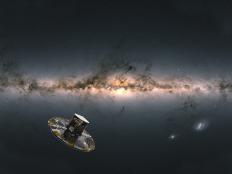All Space Articles
Showing 151 - 165 of 491 results
New Photos of Martian Space Wreckage
NASA's Ingenuity helicopter captured photos of an eerie debris field on Mars.
Scientists Watch as Stars Quake
The European Space Agency’s Gaia spacecraft has managed to watch stars tremble, their light subtly changing as starquakes ripple through their surfaces. Which is pretty cool, because Gaia wasn’t even designed to do it.
What Screaming Black Holes are Telling Us
In 2002, NASA’s orbiting X-ray observatory, the Chandra telescope, mapped out the movements of hot gas in a cluster of galaxies sitting 250 million light-years away.
The Kuiper Belt: When Solar Systems Dance
Pluto isn't alone after all. Besides being the home of Pluto, the Kuiper belt hosts dwarf planets, and smaller bits of rock and ice.
Is There Life on Venus? Something Smells Fishy…
Does the presence of a stinky gas mean there was once life on Venus?
Female Firsts: Meet Dr. Kathy Sullivan
In honor of Women's History Month, we're celebrating the achievements of women around the globe and throughout history. From the pages of The Explorers Journal, we're sharing stories from four women who broke boundaries in exploration, research, and science. In our final spotlight, meet the first American woman to walk in space and to reach the deepest known point in the ocean, Dr. Kathy Sullivan.
When Was There Life on Venus?
What we have is a cosmic whodunit. Venus, the second planet from the sun and considered by the more romantic types as "Earth's twin" and the avatar of love, is dead.
Do Giant Water Worlds Host Alien Life?
We all wish we could find an Earth 2.0 – a planet about the size of our own, made of roughly the same chemical mixture, orbiting a sun-like star at just the right distance so that all its water doesn’t evaporate or freeze.
Stuck at Home? What to See in the Night Sky this Month
In times of darkness and incertainty, opt for exploration of wonder in the skies.
Want to See a Black Hole’s Magnetic Field? Now’s Your Chance
A couple years ago, the team of astronomers with the Event Horizon Telescope wowed the world by providing our first-ever snapshot of a real-life black hole. Now they’ve done one better and mapped out the swirling magnetic fields around the monster. It’s our first ever glimpse of the forces that power the largest engines in the universe.
Farewell, Earth’s Mini-moon
It's time to say goodbye to the mini-moon that's no bigger than your car.
First Meteor Shower of 2021 Peaks This Weekend
Meet the Quadrantids. An annual meteor shower that graces the skies right around January 1. This year the shower will be competing with the light of the moon, but if you're lucky you may be able to catch it in the sky this weekend.
There’s Gold in Them Thar... Asteroids?
Gold had to come to Earth from somewhere, right? So why not outer space?
It’s Time to Say Goodbye to Arecibo
There aren’t a lot of telescopes that are also movie stars. In fact, I can think of only one: the famed Arecibo Observatory in Puerto Rico.
Odd Radio Waves Coming From Outer Space
First, some background. A huge collaboration of astronomers is currently busy spending some hard-won cash to build the world’s largest radio telescope array, called the Square Kilometre Array.


























